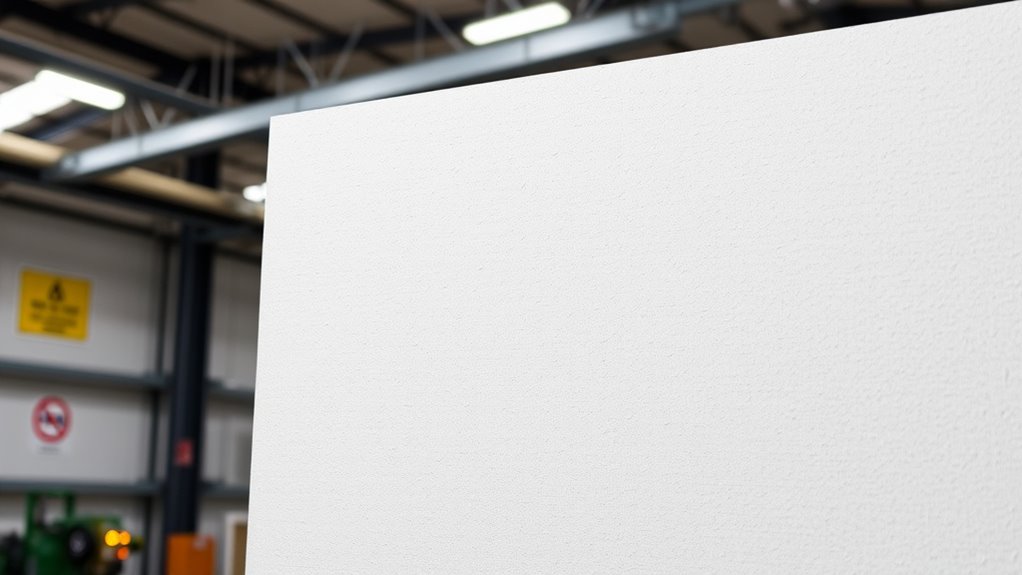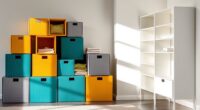You should install fire-resistant wallboards in areas with higher fire risks, such as kitchens, garages, utility rooms, and boiler rooms, where heat or flames are more likely to occur. They’re also useful in commercial buildings like storage areas, server rooms, and hallways to contain fires and protect escape routes. Properly using these panels enhances safety and compliance. Keep exploring to learn how to maximize their effectiveness in your space.
Key Takeaways
- Use in kitchens, garages, utility rooms, and boiler rooms with high fire risk.
- Install in commercial spaces like storage areas, server rooms, and data centers for fire compartmentalization.
- Reinforce load-bearing and partition walls in multi-story buildings to protect structural integrity.
- Seal joints and gaps properly to maintain fire-resistant barriers in walls and ceilings.
- Incorporate in areas requiring compliance with safety standards and building codes for enhanced fire safety.

Fire-resistant wallboards are essential for enhancing safety in residential and commercial buildings by slowing the spread of flames and smoke. When you prioritize fire safety, installing these specialized wallboards becomes a crucial part of your overall safety plan. They are designed to withstand high temperatures and help contain fires, giving you more time to evacuate and minimizing property damage. Proper drywall installation with fire-resistant materials isn’t just about meeting building codes; it’s about protecting lives and assets in the event of a fire.
Fire-resistant wallboards enhance safety by slowing fire spread and protecting lives and property.
You should consider using fire-resistant wallboards in areas where fire risk is higher, such as kitchens, garages, utility rooms, and boiler rooms. These spaces often contain appliances or materials that can ignite or accelerate a fire, so reinforcing walls with fire-rated drywall adds an extra layer of protection. Commercial buildings, especially those with large open spaces, storage areas, or server rooms, benefit considerably from incorporating fire-resistant wallboards. They help compartmentalize the space, preventing fire from spreading quickly and ensuring that escape routes remain viable longer.
The installation process is straightforward but requires attention to detail to ensure maximum effectiveness. When you perform drywall installation with fire-resistant panels, you need to follow specific guidelines, such as using the right type of fasteners and sealing joints properly. Fire-rated drywall typically comes with a special core that contains non-combustible materials, providing increased resistance. Make sure to use the appropriate fire-resistant drywall in lining walls, ceilings, and partitions where fire safety is critical. Proper sealing of joints and gaps with fire-resistant compound further enhances the barrier’s integrity, preventing smoke and flames from seeping through.
In addition to safeguarding escape routes and critical areas, fire-resistant wallboards help protect structural elements of your building. This is especially important in multi-story structures, where fire can quickly compromise load-bearing walls. When you upgrade your drywall installation with fire-resistant panels, you’re not only complying with safety standards but also investing in peace of mind. It’s a proactive approach that can considerably reduce the severity of fire damage and save lives.
Furthermore, understanding the importance of fire safety standards and ensuring proper installation can significantly influence the effectiveness of fire-resistant drywall in real emergencies. Knowing where to use fire-resistant wallboards is key to maximizing their benefits. Incorporate them into your fire safety strategy in areas prone to high heat or fire hazards, and ensure your drywall installation is performed correctly. By doing so, you create a safer environment for everyone, giving you more control over fire emergencies and helping to protect your property from devastating losses.
Frequently Asked Questions
How Long Do Fire-Resistant Wallboards Maintain Their Effectiveness?
Fire-resistant wallboards typically maintain their fire resistance longevity for about 10 to 15 years if properly installed and maintained. You should regularly inspect them for damage, cracks, or deterioration, as these can compromise their effectiveness. Keep up with maintenance requirements like cleaning and repairing minor issues promptly. Proper ventilation and avoiding excessive moisture also help guarantee the wallboards stay effective for their intended lifespan.
Are Fire-Resistant Wallboards Suitable for Outdoor Use?
You might think fire-resistant wallboards are suitable outdoors, but they’re generally not designed for weather resistance. Exposure to moisture and temperature fluctuations can compromise their integrity. While they excel indoors for fire protection, outdoor installation presents challenges like weather resistance and installation difficulties. To guarantee safety and durability, choose materials specifically made for outdoor use, as fire-resistant wallboards aren’t built to withstand harsh environmental conditions.
Can Fire-Resistant Wallboards Be Painted or Decorated?
Yes, you can paint or decorate fire-resistant wallboards. You should choose appropriate decorative finishes and painting options designed for fire-rated materials to guarantee safety and durability. Before decorating, clean the surface thoroughly and use high-quality, heat-resistant paints for best results. Keep in mind that some finishes may affect the fire-resistant properties, so always follow manufacturer guidelines and consult fire safety codes before applying any decorative treatments.
Do Fire-Resistant Wallboards Emit Any Toxic Fumes When Exposed to Fire?
Did you know that fire-resistant wallboards produce minimal smoke emissions during a fire? You won’t have to worry much about toxicity concerns, as they’re designed to limit harmful fumes. When exposed to fire, these wallboards generally emit low levels of toxic fumes, making them safer for occupants. This feature helps reduce health risks and improves fire safety, ensuring you’re better protected during emergencies.
What Are the Cost Differences Between Fire-Resistant and Regular Wallboards?
You’ll find that fire-resistant wallboards tend to be more expensive than regular ones due to higher material pricing. The installation costs might also be slightly higher because of their specialized handling and installation requirements. Overall, expect to pay a premium for fire-resistant options, but this investment enhances safety. Comparing costs, factor in both material pricing and installation to determine which option best fits your budget and safety needs.
Conclusion
Think of fire-resistant wallboards as your shield in a world full of unpredictable flames. Just as a fortress guards its inhabitants, these wallboards stand as silent protectors, symbolizing safety amid chaos. When you choose them, you’re not just installing a material; you’re building a barrier between danger and peace. Trust in their strength, and let them be the quiet guardians that keep your space secure, even when the fire’s threat looms unseen.









